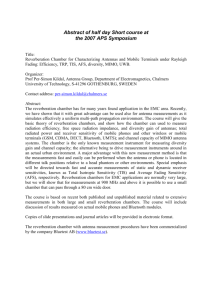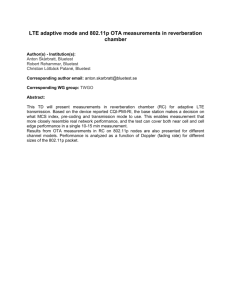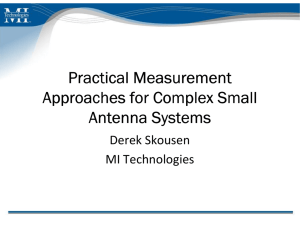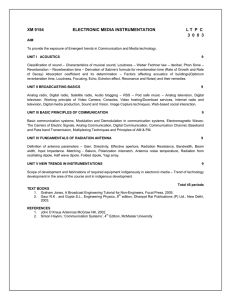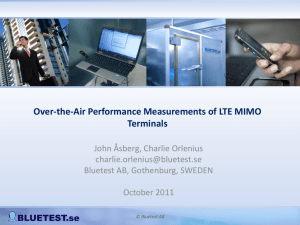A mechanical mode-stirred reverberation chamber with chaotic
advertisement
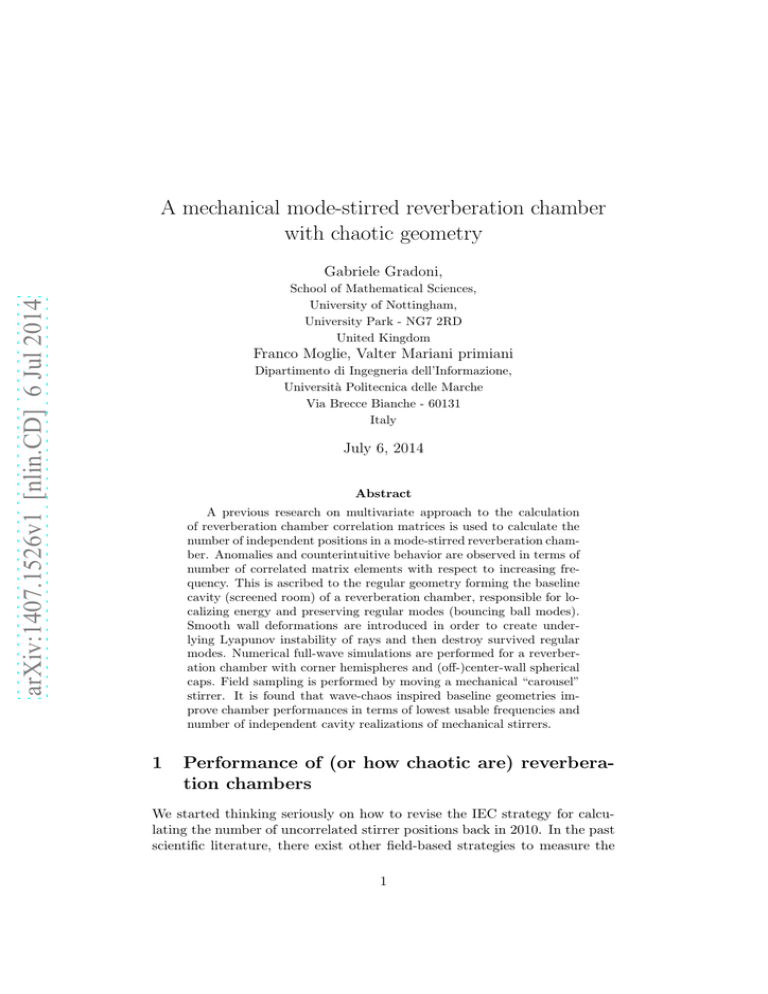
A mechanical mode-stirred reverberation chamber with chaotic geometry Gabriele Gradoni, arXiv:1407.1526v1 [nlin.CD] 6 Jul 2014 School of Mathematical Sciences, University of Nottingham, University Park - NG7 2RD United Kingdom Franco Moglie, Valter Mariani primiani Dipartimento di Ingegneria dell’Informazione, Università Politecnica delle Marche Via Brecce Bianche - 60131 Italy July 6, 2014 Abstract A previous research on multivariate approach to the calculation of reverberation chamber correlation matrices is used to calculate the number of independent positions in a mode-stirred reverberation chamber. Anomalies and counterintuitive behavior are observed in terms of number of correlated matrix elements with respect to increasing frequency. This is ascribed to the regular geometry forming the baseline cavity (screened room) of a reverberation chamber, responsible for localizing energy and preserving regular modes (bouncing ball modes). Smooth wall deformations are introduced in order to create underlying Lyapunov instability of rays and then destroy survived regular modes. Numerical full-wave simulations are performed for a reverberation chamber with corner hemispheres and (off-)center-wall spherical caps. Field sampling is performed by moving a mechanical “carousel” stirrer. It is found that wave-chaos inspired baseline geometries improve chamber performances in terms of lowest usable frequencies and number of independent cavity realizations of mechanical stirrers. 1 Performance of (or how chaotic are) reverberation chambers We started thinking seriously on how to revise the IEC strategy for calculating the number of uncorrelated stirrer positions back in 2010. In the past scientific literature, there exist other field-based strategies to measure the 1 Figure 1: An example of multivariate correlation function for the large Ancona RC facility at relatively low frequencies. A structured off-diagonal part is present. performance of mechanical stirrers [1, 2, 3, 4]. Inherently, the structure of the field-field correlation matrix carries information about the perturbation process, e.g., mechanical [5], frequency [6], space [7], time, source [8], or hybrid [9] stirring. An example of multivariate correlation matrix [10] having stirrer position pairs as elements, calculated at fixed frequency over a large chamber region, is reported in Fig. 1. The low-frequency RC behavior causes a structured off-diagonal part to appear. In the high-frequency regime, where spatial uncorrelation takes over and leads to stir uncorrelation, i.e., uncorrelation between stir trace pairs, the RC correlation matrix assumes a purely diagonal structure. Based on the concept of multi-variate correlation matrix, involving sampling through a large and dense spatial grid (lattice) rather than a single point measurement as suggested by the normative, we can estimate the number of uncorrelated stirrer positions more reliably. This actually allows for taking the spatial chaoticity of the RC into account along with the effect of moving the stirrer, as a whole. Finite-difference time-domain (FDTD) simulations highlighted an overestimation of the traditional strategy. The multi-variate approach is believed to be more robust and reliable than the IEC definition as it naturally takes into account the chaotic distribution of fields through the sampling lattice. Such an approach can be employed to different physical quantity by keeping the “thermodynamic” equilibrium of chamber fields with respect to the (macroscopic) others. As an example, it is possible to calculate the number 2 of independent lattice points , or the number of independent frequencies used in the sliding average (electronic stirring [11]) w. r. t. frequency. The outcome of such an exploration is reported in [12]. In that paper, a different approach to relate the number of independent positions to the lowest usable frequency (LUF) has been proposed based on intra-distributions of correlation matrix elements. The EMC research community actually followed this new line of enquiry along with us through the last years [13, 14, 15]. The proliferation of independent stirrer positions increases linearly from the LUF, and reaches a maximum after a transition region that is in the order of hundreds of MHz in an actual RC. Anomalies have been discovered where this number drops down suddenly in very localized frequency narrowbands, also belonging to the high frequency regime. This can be explained as follows: firstly the inefficiency of the irregular stirrer in breaking up cavity symmetry at any position and any frequency; secondly the transition from a position to another (arbitrary) one can leave residual regular modes through the detection (sub)volume. Consequently, two expedients can be adopted to improve an RC: • improve the mechanical stirrer geometry, also in view of its motion relatively to the baseline (room) cavity; • change the baseline cavity geometry in order to create field disorder independently on stirrer geometry. The first strategy has been fulfilled through the proposal of a new stirrer geometry: the so-called “carousel stirrer” [16]. In this structured, equidistant z-folded paddles are distributed through the exterior surface of a cylinder, which rotates to create cavity realizations. A scheme of the Ancona small RC facility equipped with this stirrer is reported in Fig. 2. The second strategy can be fulfilled through through geometries inspired by wave chaos, as pioneered in [17]. In particular, chaotic states have been observed in the high frequency limit of a 3D Sinai-like. However, scars have been found at relatively high frequencies, surviving wall deformations. This field enhancement localized at unstable orbits can originate from bouncing ball [18] as well as tangential [17] modes. An example of bouncing ball scar in 3D cavities is reported in [18]. To overcome this problem, in [17] it is suggested to use multiple hemispheres and spherical caps at the center or off the center of cavity walls in order to decrease the LUF of real-life reverberation chambers. This idea is pursued and refined in this study. In particular, we find that using an RC inspired by wave chaos geometries improves the performance, i.e., the effectiveness, of mechanical mode-stirrers. Figure 2 shows a few examples of baseline geometry simulated with an in-house FDTD code in order to reduce or even cancel anomalies in the production of uncorrelated stirrer positions. Therefore, we believe the joint use of wall deformations and mechanical stirrers to be a good solution. Figure 4 shows the com3 z y x Figure 2: Geometry of a the “carousel stirrer” as realized inside the small RC facility of the Laboratory of ElectroMagnetic Compatibility, Università Politecnica delle Marche, Ancona, Italy. parison between RC equipped with a “carousel” stirrer with and without deformations. It is worth noticing that, being cylindrical, the “carousel” geometry creates a (discrete, irregular) Sinai-like smooth surface enhancing wave chaotic regime. This is confirmed by FDTD full-wave simulations of the RC. The resulting field distribution is reported in Fig. 5 for a 2D plane of the 3D RC, which is clearly specked as for chaotic states. Besides reducing anomalies, there are other interesting consequences. Interestingly, we notice the presence of much more ergodic modes at low frequencies as a consequence of the chaotic dynamics created by spherical surfaces. Wave chaos implies high sensitivity to the cavity boundaries. We expect that the number of independent positions of the stirrer might change for 4 1/9 1/9 1 Figure 3: Geometry of a reverberation chamber with walls deformed through hemispheres and spherical caps. different boundary geometries, i.e., either the polygonal geometry proposed originally or the wave-chaos inspired geometry proposed recently should behave differently. Further work is in progress to visualize fields at those anomalous frequencies, where we expect to find scars and regular tangential modes that localize energy in spatial region not affected by the presence of a stirrer. 2 Acknowledgements G. G. acknowledges hospitality and financial support from DII, Università Politecnica delle Marche, Ancona, Italy, within the Campus World program “Visiting Scientist”, through May 2014. References [1] P. Corona, J. Ladbury, and G. Latmiral, “Reverberation-chamber research-then and now: a review of early work and comparison with current understanding,” Electromagnetic Compatibility, IEEE Transactions on, vol. 44, no. 1, pp. 87–94, Feb 2002. [2] J. Clegg, A. Marvin, J. Dawson, and S. Porter, “Optimization of stirrer designs in a reverberation chamber,” Electromagnetic Compatibility, IEEE Transactions on, vol. 47, no. 4, pp. 824–832, Nov 2005. 5 600 senza sfere 4 nei corner 4 nei corner + calotta 500 Nind 400 300 200 100 0 0 0.2 0.4 0.6 Frequency (GHz) 0.8 1 Figure 4: Uncorrelated stirrer position versus frequency. The presence of corner spheres and spherical caps results beneficial in removing anomalies and in improving low frequency sirrer efficiency. [3] C. Holloway, D. Hill, J. Ladbury, and G. Koepke, “Requirements for an effective reverberation chamber: unloaded or loaded,” Electromagnetic Compatibility, IEEE Transactions on, vol. 48, no. 1, pp. 187–194, Feb 2006. [4] R. Serra and J. Nijenhuis, “Wave impedance in reverberation chambers,” Electromagnetic Compatibility, IEEE Transactions on, vol. 56, no. 1, pp. 231–234, Feb 2014. [5] J. G. Kostas and B. Boverie, “Statistical model for a mode-stirred chamber,” IEEE Trans. EMC, vol. 33, p. 366, 1991. [6] D. A. Hill, “Electronic mode stirring for reverberation chambers,” IEEE Trans. EMC, vol. 36, p. 294, 1994. [7] L. Arnaut, “Operation of electromagnetic reverberation chambers with wave diffractors at relatively low frequencies,” Electromagnetic Compatibility, IEEE Transactions on, vol. 43, no. 4, pp. 637 –653, nov 2001. [8] G. Cerri, V. Primiani, C. Monteverde, and P. Russo, “A theoretical feasibility study of a source stirring reverberation chamber,” Electromagnetic Compatibility, IEEE Transactions on, vol. 51, no. 1, pp. 3–11, Feb 2009. 6 Figure 5: Chaotic (speckled) field distribution of a 2D plane of the 3D RC. [9] G. Gradoni and L. Arnaut, “Generalized extreme-value distributions of power near a boundary inside electromagnetic reverberation chambers,” Electromagnetic Compatibility, IEEE Transactions on, vol. 52, no. 3, pp. 506–515, Aug 2010. [10] G. Gradoni, V. Mariani Priamiani, and F. Moglie, “Reverberation chamber as a multivariate process: FDTD evaluation of correlation matrix and independent positions,” Progress In Electromagnetics Research, vol. 133, pp. 217–234, 2013. [11] D. A. Hill, “Plane wave integral representation for fields in reverberation chambers,” IEEE Trans. EMC, vol. 40, p. 209, 1998. [12] G. Gradoni, F. Moglie, and V. Primiani, “Use of correlation matrix to assess the stirring performance of a reverberation chamber: a comparative study,” arXiv:1404.6335v1 [physics.data-an], April 2014. [13] H. G. Krauthäuser, “Number of samples required to meet a field inhomogeneity limit with given confidence in reverberation chambers,” IEEE Transactions in Electromagnetic Compatibility, vol. 54, no. 5, pp. 968–975, Oct. 2012. [14] X. Chen, “On independent platform sample number for reverberation chamber measurements,” IEEE Transactions in Electromagnetic Compatibility, vol. 54, no. 6, pp. 1306–1309, Dec. 2012. 7 [15] F. Monsef and A. Cozza, “Average number of significant modes excited in a mode-stirred reverberation chamber,” Electromagnetic Compatibility, IEEE Transactions on, vol. 56, no. 2, pp. 259–265, April 2014. [16] F. Moglie and V. Mariani Primiani, “Numerical analysis of a new location for the working volume inside a reverberation chamber,” IEEE Transactions in Electromagnetic Compatibility, vol. 54, no. 2, pp. 238– 245, Apr. 2012. [17] J.-B. Gros, O. Legrand, F. Mortessagne, E. Richalot, and K. Selemani, “Universal behaviour of a wave chaos based electromagnetic reverberation chamber,” Wave Motion, vol. 51, no. 4, pp. 664 – 672, 2014, innovations in Wave Modelling. [18] H.-J. Stöckmann, “Chaos in microwave resonators,” Poincare, vol. IX, pp. 1–40, 2006. 8 Seminaire
